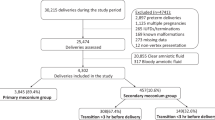Abstract
Objective
We sought to determine whether meconium-stained amniotic fluid is based on chronic hypoxia or not? In case of chronic hypoxia, higher red blood cell (Rbc) count and/or total hemoglobin levels (Hgb) and/or higher fetal hemoglobin (HbF) and/or lower adult hemoglobin (HbA) levels were expected when compared with controls.
Design
Case–control study.
Setting
Obstetric unit of a tertiary ministry of health hospital.
Sample
Fifty singleton pregnancies with meconium-stained amniotic fluid and 50 singleton pregnancies with clear amniotic fluid at all stages of labor.
Methods
Umbilical cord blood samples were collected for determination of total blood parameters and hemoglobin electrophoresis.
Main outcome measures
Red blood cell count, total hemoglobin, fetal and adult hemoglobin contents (HbF and HbA).
Results
Red blood cell count, total hemoglobin, fetal hemoglobin (HbF) and adult hemoglobin (HbA) contents were not different between meconium stained and clear amniotic fluid groups.
Conclusion
These results suggest that meconium passage may not be associated with chronic fetal hypoxia as demonstrated by similar red blood cell count, total hemoglobin values and fetal hemoglobin (HbF) and adult hemoglobin (HbA) contents.
Similar content being viewed by others
References
Oyelese Y, Culin A, Ananth CV, Kaminsky LM, Vintzileos A, Smulian JC (2006) Meconium- stained amniotic fluid across gestation and neonatal acid-base status. Obstet Gynecol 108:345–349
Tran SH, Caughey AB, Musci TJ (2003) Meconium-stained amniotic fluid is associated with puerperal infections. Am J Obstet Gynecol 189:746–750
Sedaghatian MR, Othman L, Hossain MM, Vidyasagar D (2000) Risk of meconium-stained amniotic fluid in different ethnic groups. J Perinatol 20:257–261
Berkus MD, Langer O, Samueloff A, Xenakis EM, Field NT, Ridgway LE (1994) Meconium-stained amniotic fluid: increased risk for adverse neonatal outcome. Obstet Gynecol 84:115–120
Naeye RL, Peters EC, Bartholomew M, Landis JR (1989) Origins of cerebral palsy. Am J Dis Child 143:1154–1161
Maymon E, Chaim W, Furman B, Ghezzi F, Shoham Vardi I, Mazor M 1998 Meconium stained amniotic fluid in very low risk pregnancies at term gestation. Eur J Obstet Gynecol Reprod Biol 80:169–173
Matthews TG, Warshaw JB (1979) Relevance of the gestational age distribution of meconium passage in utero. Pediatrics 64:30–31
Kaplan C (1993) Placental pathology for the nineties. Pathol Annu 28:15–72
Gregory GA, Gooding CA, Phibbs RH et al. (1974) Meconium aspiration in infants a prospective study. J Pediatr 85:848–852
Brown CA, Desmond MM, Lindley JE et al. (1957) Meconium staining of the amniotic fluid; a marker of fetal hypoxia. Obstet Gynecol 9:91–103
Richey SD, Ramin SM, Bawdon RE et al. (1995) Markers of acute and chronic asphyxia in infants with meconium-stained amniotic fluid. Am J Obstet Gynecol 172:1212–1215
Jazayeri A, Politz L, Tsibris JC et al. (2000) Fetal erythropoietin levels in pregnancies complicated by meconium passage: does meconium suggest fetal hypoxia? Am J Obstet Gynecol 183:188–190
Manning FA, Harman CR, Morrison I et al. (1990) Fetal assessment based on fetal biophysical profile scoring. IV. An analysis of perinatal morbidity and mortality. Am J Obstet Gynecol 162:703–709
Emmanouilides GC, Townsend DE, Bauer RA (1968) Effects of single umbilical artery ligation in the lamb fetus. Pediatrics 42:919–927
Rogers MS, Wang W, Mongelli M, Pang CP, Duley JA, Chang AM (1997) Lipid peroxidation in cord blood at birth: a marker of fetal hypoxia during labour. Gynecol Obstet Invest 44:229–233
Liu BY, Wang CC, Lau TK, Chu CY, Phil M, Pang CP, Rogers MS, Leung TN (2005) Meconium-stained liquor during labor is associated with raised neonatal cord blood 8-iso-prostaglandin F2alpha concentration. Am J Obstet Gynecol 192:289–294
Royal College of Obstetricians, Gynaecologists (2001) The use of electronic fetal monitoring: evidence-based clinical guideline number 8. Royal College of Obstetricians and Gynaecologists, London
Clifford SH (1945) Clinical significance of yellow staining of the vernix caseosa, skin, nails and umbilical cord of the newborn. Am J Dis Child 69:327–328
Walker J (1954) Foetal anoxia. J Obstet Gynaecol Br Emp 61:162–180
Diamant S, Kissilevitz R, Diamant Y (1980) Lipid peroxidation system in human placental tissue: general properties and the influence of gestational age. Biol Reprod 23:776–781
Grignaffini A, Soncini E, Ronzoni E, Piazza E, Anfuso S, Vadora E (2004) Meconium-stained amniotic fluid and fetal oxygen saturation measured by pulse oximetry during labour. Acta Biomed 75(Suppl 1):45–52
Hellegers AE, Schruefer JJP (1961) Normograms and empirical equations relating oxygen tension, percentage saturation, and pH in maternal and fetal blood. Am J Obstet Gynecol 81:377
Bunn HF, Jandl JH (1970) Control of hemoglobin function within the red cell. N Engl J Med 282:1414
Ohls RK (2004) Developmental erythropoiesis. In: Polin RA, Fox WW, Abman SH (eds) Fetal and neonatal physiology. (3rd edn). Saunders, Philadelphia, pp 1399–1420
Acknowledgements
Conflict of interest statement: All the authors declare that there are no conflicts of interest.
Author information
Authors and Affiliations
Corresponding author
Rights and permissions
About this article
Cite this article
Simsek, A., Celen, S., İslimye, M. et al. A long-standing incomprehensible matter of obstetrics: meconium-stained amniotic fluid, a new approach to reason. Arch Gynecol Obstet 278, 559–563 (2008). https://doi.org/10.1007/s00404-008-0627-2
Received:
Accepted:
Published:
Issue Date:
DOI: https://doi.org/10.1007/s00404-008-0627-2




